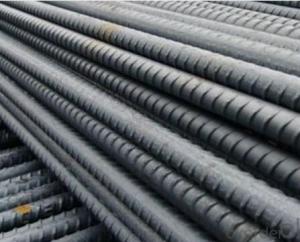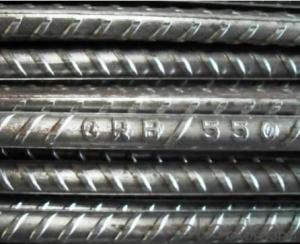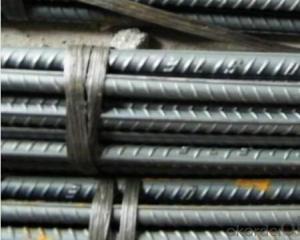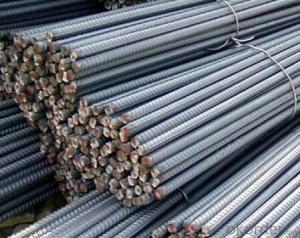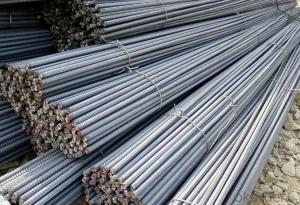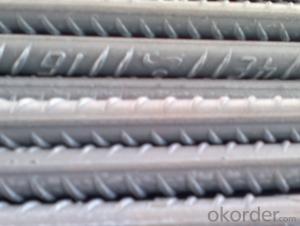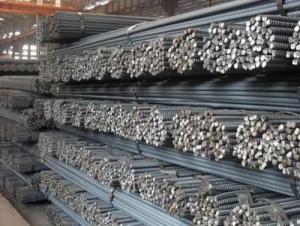Deformed Steel Bar with Standard ASTM A615
- Loading Port:
- Tianjin
- Payment Terms:
- TT OR LC
- Min Order Qty:
- 100 m.t.
- Supply Capability:
- 5000 m.t./month
OKorder Service Pledge
OKorder Financial Service
You Might Also Like
Product Description:
OKorder is offering Deformed Steel Bar with Standard ASTM A615 at great prices with worldwide shipping. Our supplier is a world-class manufacturer of steel, with our products utilized the world over. OKorder annually supplies products to European, North American and Asian markets. We provide quotations within 24 hours of receiving an inquiry and guarantee competitive prices.
Product Applications:
Deformed Steel Bar with Standard ASTM A615 are ideal for structural applications and are widely used in the construction of buildings and bridges, and the manufacturing, petrochemical, and transportation industries.
Product Advantages:
OKorder's Deformed Steel Bar with Standard ASTM A615 are durable, strong, and resist corrosion.
Main Product Features:
· Premium quality
· Prompt delivery & seaworthy packing (30 days after receiving deposit)
· Corrosion resistance
· Can be recycled and reused
· Mill test certification
· Professional Service
· Competitive pricing
Specifications of Deformed Steel Bar with Standard ASTM A615:
Standard | GB UK USA | HRB335 HRB400 HRB500 G460B, B500A, B500B,B500C GR40, GR60 | |
Diameter | 6mm,8mm,10mm,12mm,14mm,16mm,18mm,20mm, 22mm,25mm,28mm,32mm,36mm,40mm,50mm | ||
Length | 6M, 9M,12M or as required | ||
Packing | Export standard packing: wrapped by wire rod in bundles | ||
Each bundle weight | 2-3MT, or as required | ||
Trade terms | FOB, CFR, CIF | ||
Payment terms | TT payment in advance or Irrevocable LC at sight. | ||
Delivery Detail | within 45 days after received advanced payment or LC. | ||
Brand name | DRAGON | ||
Theoretical weight and section area of each diameter as below for your information:
Diameter(mm) | Section area (mm²) | Mass(kg/m) | Weight of 12m (kg) | Pcs/ton |
6 | 28.27 | 0.222 | 2.664 | 375.38 |
8 | 50.27 | 0.395 | 4.74 | 210.97 |
10 | 78.54 | 0.617 | 7.404 | 135.06 |
12 | 113.1 | 0.888 | 10.656 | 93.84 |
14 | 153.9 | 1.21 | 14.52 | 68.87 |
16 | 201.1 | 1.58 | 18.96 | 52.74 |
18 | 254.5 | 2.00 | 24 | 41.67 |
20 | 314.2 | 2.47 | 29.64 | 33.74 |
22 | 380.1 | 2.98 | 35.76 | 27.96 |
25 | 490.9 | 3.85 | 46.2 | 21.65 |
28 | 615.8 | 4.83 | 57.96 | 17.25 |
32 | 804.2 | 6.31 | 75.72 | 13.21 |
36 | 1018 | 7.99 | 98.88 | 10.43 |
40 | 1257 | 9.87 | 118.44 | 8.44 |
50 | 1964 | 15.42 | 185.04 | 5.40 |
Chemical Composition: (Please kindly find our chemistry of our material based on JIS as below for your information)
JISG3112 SD390 | Chemical Composition | ||||
C | Mn | Si | S | P | |
0.22 | 1.38 | 0.4 | 0.014 | 0.022 | |
Physical capability | |||||
Yield Strength(N/cm²) | Tensile Strength(N/cm²) | Elongation (%) | |||
620 | ≥400 | 21 | |||
The production process of Deformed Steel Bar with Standard ASTM A615
1-Waling beam furnace
2-Roughing rolling group
3-Intermediate rolling train
4-Finishing rolling group
5-Water-cooling device
6-Walking beam cooler
7-Finishing equipment(including the cold scale shear,short feet collection system,
automatic counting device,bundling machine, collect bench)
Usage and Applications of Deformed Steel Bar with Standard ASTM A615:
Deformed bar is widely used in buildings, bridges, roads and other engineering construction. Big to highways, railways, bridges, culverts, tunnels, public facilities such as flood control, dam, small to housing construction, beam, column, wall and the foundation of the plate, deformed bar is an integral structure material. With the development of world economy and the vigorous development of infrastructure construction, real estate, the demand for deformed bar will be larger and larger..
Packaging & Delivery of Deformed Steel Bar with Standard ASTM A615:
Packaging Detail: products are packed in bundle and then shipped by container or bulk vessel, deformed bar is usually naked strapping delivery, when storing, please pay attention to moisture proof. The performance of rust will produce adverse effect.
Price: Keep lower operating costs so as to offer competitive price for our clients
FAQ:
Q1: Why buy Materials & Equipment from OKorder.com?
A1: All products offered byOKorder.com are carefully selected from China's most reliable manufacturing enterprises. Through its ISO certifications, OKorder.com adheres to the highest standards and a commitment to supply chain safety and customer satisfaction.
Q2: How do we guarantee the quality of our products?
A2: We have established an advanced quality management system which conducts strict quality tests at every step, from raw materials to the final product. At the same time, we provide extensive follow-up service assurances as required.
Q3: How soon can we receive the product after purchase?
A3: Within three days of placing an order, we will begin production. The specific shipping date is dependent upon international and government factors, but is typically 7 to 10 workdays.
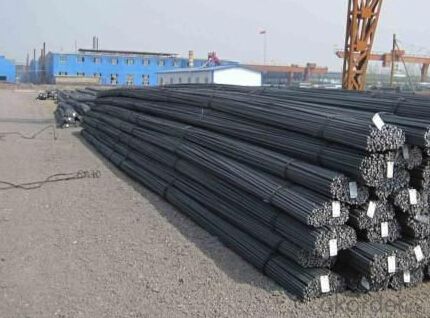
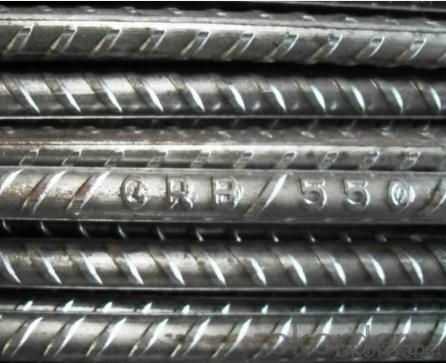
- Q:How are steel rebars different from steel mesh?
- Steel rebars and steel mesh are both reinforcing materials used in construction, but they differ in terms of their shape, size, and application. Steel rebars are long, cylindrical bars typically made of carbon steel and are used to provide tensile strength and stability to concrete structures, such as beams, columns, and foundations. On the other hand, steel mesh consists of a grid-like pattern of interconnected steel wires and is used primarily to reinforce concrete slabs, walls, and other flat surfaces. While rebars are primarily used to resist tension, steel mesh distributes loads evenly and helps prevent cracking and shrinkage in concrete.
- Q:Are steel rebars magnetic?
- Yes, steel rebars are magnetic.
- Q:How do steel rebars prevent the concrete from cracking under tension?
- Steel rebars reinforce concrete and increase its structural integrity, preventing cracking under tension. Concrete has low tensile strength and tends to crack when subjected to tensile forces. However, when steel rebars are embedded in the concrete, they absorb and distribute these forces, acting as reinforcement. Typically made of high-strength steel, the rebars have a much higher tensile strength compared to concrete. As a result, when the concrete is under tension, the rebars bear most of the load, preventing cracking. The rebars act as a framework or skeleton within the concrete, resisting the tensile forces and ensuring its structural stability. Furthermore, the bond between the steel rebar and the concrete also plays a role in preventing cracking under tension. The ribbed or deformed surface of the rebars enhances the bond with the surrounding concrete, creating a strong connection. This bond allows the rebars to transfer the tensile forces to the concrete matrix more effectively, reducing the risk of cracking. By reinforcing the concrete, steel rebars help distribute the tensile forces evenly throughout the structure. This prevents localized stress concentrations and minimizes the chances of cracks forming. Additionally, if cracks do occur, the presence of rebars can help control their propagation by acting as barriers that restrict further spread. In conclusion, steel rebars provide reinforcement, increase the strength of concrete, and prevent cracking under tension. They bear the tensile forces, distribute them evenly, and enhance the bond between the rebar and the concrete. This reinforcement ensures the structural integrity of the concrete and helps prevent cracking.
- Q:Are steel rebars suitable for use in wastewater treatment plants?
- Yes, steel rebars are suitable for use in wastewater treatment plants. They provide excellent strength and durability, making them ideal for reinforcing concrete structures in such environments. Additionally, steel rebars are corrosion-resistant, which is crucial in wastewater treatment plants where exposure to chemicals and moisture is common.
- Q:What are the different types of steel rebars used in high-rise buildings?
- The different types of steel rebars commonly used in high-rise buildings include carbon steel rebars, epoxy-coated rebars, stainless steel rebars, and galvanized rebars. These rebars have varying properties and are chosen based on factors like strength, corrosion resistance, and durability to ensure structural integrity and safety in the building's construction.
- Q:What are the standard sizes for steel rebars?
- The standard sizes for steel rebars typically range from #3 to #18, with diameters ranging from 3/8 inch to 2 1/4 inches.
- Q:How do steel rebars contribute to the fire resistance of a building?
- Steel rebars contribute to the fire resistance of a building by providing structural support and enhancing the overall stability of the structure. In the event of a fire, the steel rebars help maintain the structural integrity of the building, preventing collapse and allowing occupants more time to evacuate safely. Additionally, steel has a high melting point and low thermal conductivity, which slows down the spread of fire and heat through the building, providing firefighters with more time to control the situation.
- Q:Can steel rebars be used in the construction of dams or reservoirs?
- Yes, steel rebars can be used in the construction of dams or reservoirs. Steel rebars provide structural reinforcement and enhance the strength and durability of concrete structures, making them suitable for large-scale projects like dams and reservoirs.
- Q:What are the precautions to be taken while welding steel rebars?
- When welding steel rebars, there are several precautions that need to be taken to ensure safe and effective welding: 1. Proper ventilation: Welding generates fumes and gases that can be harmful if inhaled. Therefore, it is important to work in a well-ventilated area or use exhaust systems to remove the fumes and maintain a safe breathing environment. 2. Personal protective equipment (PPE): Welders should always wear appropriate PPE, including a welding helmet or face shield, safety glasses, welding gloves, flame-resistant clothing, and steel-toed boots. This protective gear helps minimize the risk of burns, eye injuries, and other physical hazards. 3. Fire prevention: Welding involves intense heat and sparks, which can ignite flammable materials. Before starting the welding process, ensure that the work area is clear of any combustible materials, and have a fire extinguisher nearby. It is also advisable to have a fire watch person present to monitor the area for any potential fire hazards. 4. Grounding: Proper grounding is essential to prevent electrical shocks during welding. Ensure that the welding machine is properly grounded, and the workpiece is connected to a reliable grounding point. 5. Preparing the surface: Before welding, the surfaces of the rebars should be clean and free from any oils, grease, dirt, or rust. Use a wire brush or grinder to remove any contaminants, as they can affect the quality of the weld. 6. Welding technique: Employing the correct welding technique is crucial for achieving strong and reliable welds. Follow the recommended welding parameters, such as the appropriate current, voltage, and electrode diameter, to ensure optimal results. It is also important to maintain a steady hand and a consistent travel speed to prevent weld defects. 7. Training and experience: Welding steel rebars requires skill and knowledge. Ensure that the welder is properly trained and experienced in working with rebars. This will help minimize errors and ensure that the welds meet the required standards and specifications. By adhering to these precautions, welders can significantly reduce the risk of accidents, injuries, and subpar weld quality when working with steel rebars.
- Q:Are steel rebars susceptible to rust?
- Yes, steel rebars are susceptible to rust.
1. Manufacturer Overview |
|
|---|---|
| Location | |
| Year Established | |
| Annual Output Value | |
| Main Markets | |
| Company Certifications | |
2. Manufacturer Certificates |
|
|---|---|
| a) Certification Name | |
| Range | |
| Reference | |
| Validity Period | |
3. Manufacturer Capability |
|
|---|---|
| a)Trade Capacity | |
| Nearest Port | |
| Export Percentage | |
| No.of Employees in Trade Department | |
| Language Spoken: | |
| b)Factory Information | |
| Factory Size: | |
| No. of Production Lines | |
| Contract Manufacturing | |
| Product Price Range | |
Send your message to us
Deformed Steel Bar with Standard ASTM A615
- Loading Port:
- Tianjin
- Payment Terms:
- TT OR LC
- Min Order Qty:
- 100 m.t.
- Supply Capability:
- 5000 m.t./month
OKorder Service Pledge
OKorder Financial Service
Similar products
New products
Hot products
Hot Searches
Related keywords
